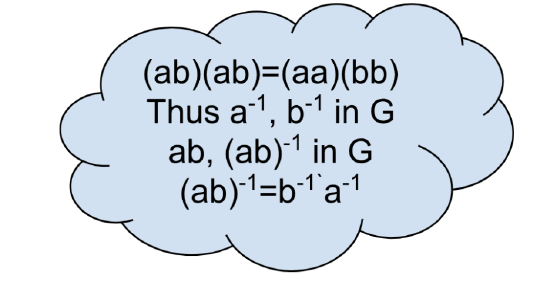2.2: Properties of Group Elements
- Page ID
- 131256
\( \newcommand{\vecs}[1]{\overset { \scriptstyle \rightharpoonup} {\mathbf{#1}} } \)
\( \newcommand{\vecd}[1]{\overset{-\!-\!\rightharpoonup}{\vphantom{a}\smash {#1}}} \)
\( \newcommand{\id}{\mathrm{id}}\) \( \newcommand{\Span}{\mathrm{span}}\)
( \newcommand{\kernel}{\mathrm{null}\,}\) \( \newcommand{\range}{\mathrm{range}\,}\)
\( \newcommand{\RealPart}{\mathrm{Re}}\) \( \newcommand{\ImaginaryPart}{\mathrm{Im}}\)
\( \newcommand{\Argument}{\mathrm{Arg}}\) \( \newcommand{\norm}[1]{\| #1 \|}\)
\( \newcommand{\inner}[2]{\langle #1, #2 \rangle}\)
\( \newcommand{\Span}{\mathrm{span}}\)
\( \newcommand{\id}{\mathrm{id}}\)
\( \newcommand{\Span}{\mathrm{span}}\)
\( \newcommand{\kernel}{\mathrm{null}\,}\)
\( \newcommand{\range}{\mathrm{range}\,}\)
\( \newcommand{\RealPart}{\mathrm{Re}}\)
\( \newcommand{\ImaginaryPart}{\mathrm{Im}}\)
\( \newcommand{\Argument}{\mathrm{Arg}}\)
\( \newcommand{\norm}[1]{\| #1 \|}\)
\( \newcommand{\inner}[2]{\langle #1, #2 \rangle}\)
\( \newcommand{\Span}{\mathrm{span}}\) \( \newcommand{\AA}{\unicode[.8,0]{x212B}}\)
\( \newcommand{\vectorA}[1]{\vec{#1}} % arrow\)
\( \newcommand{\vectorAt}[1]{\vec{\text{#1}}} % arrow\)
\( \newcommand{\vectorB}[1]{\overset { \scriptstyle \rightharpoonup} {\mathbf{#1}} } \)
\( \newcommand{\vectorC}[1]{\textbf{#1}} \)
\( \newcommand{\vectorD}[1]{\overrightarrow{#1}} \)
\( \newcommand{\vectorDt}[1]{\overrightarrow{\text{#1}}} \)
\( \newcommand{\vectE}[1]{\overset{-\!-\!\rightharpoonup}{\vphantom{a}\smash{\mathbf {#1}}}} \)
\( \newcommand{\vecs}[1]{\overset { \scriptstyle \rightharpoonup} {\mathbf{#1}} } \)
\( \newcommand{\vecd}[1]{\overset{-\!-\!\rightharpoonup}{\vphantom{a}\smash {#1}}} \)
\(\newcommand{\avec}{\mathbf a}\) \(\newcommand{\bvec}{\mathbf b}\) \(\newcommand{\cvec}{\mathbf c}\) \(\newcommand{\dvec}{\mathbf d}\) \(\newcommand{\dtil}{\widetilde{\mathbf d}}\) \(\newcommand{\evec}{\mathbf e}\) \(\newcommand{\fvec}{\mathbf f}\) \(\newcommand{\nvec}{\mathbf n}\) \(\newcommand{\pvec}{\mathbf p}\) \(\newcommand{\qvec}{\mathbf q}\) \(\newcommand{\svec}{\mathbf s}\) \(\newcommand{\tvec}{\mathbf t}\) \(\newcommand{\uvec}{\mathbf u}\) \(\newcommand{\vvec}{\mathbf v}\) \(\newcommand{\wvec}{\mathbf w}\) \(\newcommand{\xvec}{\mathbf x}\) \(\newcommand{\yvec}{\mathbf y}\) \(\newcommand{\zvec}{\mathbf z}\) \(\newcommand{\rvec}{\mathbf r}\) \(\newcommand{\mvec}{\mathbf m}\) \(\newcommand{\zerovec}{\mathbf 0}\) \(\newcommand{\onevec}{\mathbf 1}\) \(\newcommand{\real}{\mathbb R}\) \(\newcommand{\twovec}[2]{\left[\begin{array}{r}#1 \\ #2 \end{array}\right]}\) \(\newcommand{\ctwovec}[2]{\left[\begin{array}{c}#1 \\ #2 \end{array}\right]}\) \(\newcommand{\threevec}[3]{\left[\begin{array}{r}#1 \\ #2 \\ #3 \end{array}\right]}\) \(\newcommand{\cthreevec}[3]{\left[\begin{array}{c}#1 \\ #2 \\ #3 \end{array}\right]}\) \(\newcommand{\fourvec}[4]{\left[\begin{array}{r}#1 \\ #2 \\ #3 \\ #4 \end{array}\right]}\) \(\newcommand{\cfourvec}[4]{\left[\begin{array}{c}#1 \\ #2 \\ #3 \\ #4 \end{array}\right]}\) \(\newcommand{\fivevec}[5]{\left[\begin{array}{r}#1 \\ #2 \\ #3 \\ #4 \\ #5 \\ \end{array}\right]}\) \(\newcommand{\cfivevec}[5]{\left[\begin{array}{c}#1 \\ #2 \\ #3 \\ #4 \\ #5 \\ \end{array}\right]}\) \(\newcommand{\mattwo}[4]{\left[\begin{array}{rr}#1 \amp #2 \\ #3 \amp #4 \\ \end{array}\right]}\) \(\newcommand{\laspan}[1]{\text{Span}\{#1\}}\) \(\newcommand{\bcal}{\cal B}\) \(\newcommand{\ccal}{\cal C}\) \(\newcommand{\scal}{\cal S}\) \(\newcommand{\wcal}{\cal W}\) \(\newcommand{\ecal}{\cal E}\) \(\newcommand{\coords}[2]{\left\{#1\right\}_{#2}}\) \(\newcommand{\gray}[1]{\color{gray}{#1}}\) \(\newcommand{\lgray}[1]{\color{lightgray}{#1}}\) \(\newcommand{\rank}{\operatorname{rank}}\) \(\newcommand{\row}{\text{Row}}\) \(\newcommand{\col}{\text{Col}}\) \(\renewcommand{\row}{\text{Row}}\) \(\newcommand{\nul}{\text{Nul}}\) \(\newcommand{\var}{\text{Var}}\) \(\newcommand{\corr}{\text{corr}}\) \(\newcommand{\len}[1]{\left|#1\right|}\) \(\newcommand{\bbar}{\overline{\bvec}}\) \(\newcommand{\bhat}{\widehat{\bvec}}\) \(\newcommand{\bperp}{\bvec^\perp}\) \(\newcommand{\xhat}{\widehat{\xvec}}\) \(\newcommand{\vhat}{\widehat{\vvec}}\) \(\newcommand{\uhat}{\widehat{\uvec}}\) \(\newcommand{\what}{\widehat{\wvec}}\) \(\newcommand{\Sighat}{\widehat{\Sigma}}\) \(\newcommand{\lt}{<}\) \(\newcommand{\gt}{>}\) \(\newcommand{\amp}{&}\) \(\definecolor{fillinmathshade}{gray}{0.9}\)Let \((G, \ast)\) be a group. Then
-
The identity is unique,
-
For each \(a \in G\), one and only one inverse exists.
-
For each \(a \in G, \ (a^{-1})^{-1}=a\).
-
\((a\ast b)^{-1}=b^{-1} \ast a^{-1}, \forall a,b \in G.\)
Note if \(G\) is abelian,\((a\ast b)^{-1}=b^{-1} \ast a^{-1}=a^{-1} \ast b^{-1}, \forall a,b \in G\).
5. If \(xy=xz, \forall x,y,z \in G\), then \(y=z\). (Left cancellation)
6. If \(yx=zx, \forall x,y,z \in G\), then \(y=z\). (Right cancellation)
- Answer
-
Proof:
Let \((G,\ast)\) be a group.
1. We shall show that identity is unique.
Assume that \(G\) has two identity elements, \(e_1\) and \(e_2\).
Thus \(a \ast e_1=e_1 \ast a=a\) and \(a \ast e_2=e_2 \ast a=a\), \(\forall a \in G\).
We will show that \(e_1=e_2\).
Consider \(e_1 \ast e_2=e_2 \ast e_1 =e_1\) and \(e_2 \ast e_1=e_1 \ast e_2 =e_2\).
Thus since \(e_1=e_2\), the identity is unique.◻
2. We shall show that for each \(a \in G\), one and only one inverse exists.
Let \(a \in G\).
Assume that \(a\) has two inverses, \(b\) and \(c\).
Then \(a \ast b=b \ast a=e\) and \(a \ast c=c \ast a=e\).
We shall show that \(b=c\).
Consider \(b=b \ast e\)
\(=b \ast(a \ast c)\)
\(=(b \ast a) \ast c\)
\(=e \ast c\)
\(=c\).
Thus \(b=c\) and for each \(a \in G\), there exists one and only one inverse.
3. We shall show that for each \(a \in G, \ (a^{-1})^{-1}=a\).
Let \(a \in G\). Then \(a \ast a^{-1}=a^{-1}\ast a=e\).
Thus \((a^{-1})^{-1}=b^{-1}=a\).
Assume that \(G\) has two identity elements, \(e_1\) and \(e_2\).
Thus \(a \ast e_1=e_1 \ast a=a\) and \(a \ast e_2=e_2 \ast a=a\), \(\forall a \in G\).
We will show that \(e_1=e_2\).
Consider \(e_1 \ast e_2=e_2 \ast e_1 =e_1\) and \(e_2 \ast e_1=e_1 \ast e_2 =e_2\).
Thus since \(e_1=e_2\), the identity is unique.◻
4.
Let \(a,b \in G\).
Then \(a \ast b \in G\), \(a^{-1} \in G\), \(b^{-1} \in G\) and \(a \ast b \in G\).
Consider \((b^{-1} \ast a^{-1})(a \ast b)= b^{-1} \ast (a^{-1}a) \ast b)\)
\(=b^{-1}\ast e \ast b\)
\(=b^{-1}\ast b\)
\(=e\).
And consider \((a \ast b)(b^{-1} \ast a^{-1})=a \ast ( b^{-1} \ast b) \ast a^{-1}\)
\(=a^{-1}\ast e \ast a\)
\(=a^{-1}\ast a\)
\(=e\).
Since \((b^{-1} \ast a^{-1})(a \ast b)=e= (a \ast b)(b^{-1} \ast a^{-1})\), then \((a\ast b)^{-1}=b^{-1} \ast a^{-1}, \forall a,b \in G\).◻
5.
Let \(x,y,z \in G\) s.t. \(xy=xz\).
Note: \(x^{-1} \in G\) since \(G\) is a group.
Thus \(x^{-1}(xy)=x^{-1}(xz)\)
Thus \((x^{-1}x)y=(x^{-1}x)z\) since associative.
Thus \(ey=ez\) and \(y=z\).◻
6.
Let \(x,y,z \in G\) s.t. \(y \ast x=z \ast x\).
Note: \(x^{-1} \in G\) since \(G\) is a group.
Thus \((y \ast x) \ast x^{-1}=(z \ast x) \ast x^{-1}\)
Thus \(y \ast (x^{-1} \ast x)=z \ast (x^{-1} \ast x)\) since associative.
Thus \(y \ast e=z \ast e\) and \(y=z\).◻
Let \(G\) be a group.
Let \(g,h \in G\) and \(m,n \in \mathbb{N}\).
Then
-
\(g^m \ast g^n=g^{m+n}\) where \(g^m=g \ast \cdots \ast g\). Note there would be \(m\) \(g\)’s.
-
\((g^m)^n=g^{mn}\).
-
\((gh)^{-m}=(h^{-1} g^{-1})^m\).
With the addition operation \(g^m=mg.\)
Let \(G\) be a group and suppose that \((ab)^2=a^2b^2\) for all \(a\) and \(b\) in \(G\). Prove that \(G\) is an abelian group.
Solution

Let \(G\) be a group.
Let \((ab)^2=a^2b^2, \; \forall a,b \in G\).
We shall show that \(G\) is abelian.
Let \(a,b \in G\).
We shall show that \(ab=ba\).
Note that \((a \star b)\star (a \star b)= (a \star a) \star (b \star b)\).
Consider that \(a^{-1} \star (a \star b) \star (a \star b)\star b^{-1}=a^{-1} \star (a \star a) \star (b \star b) \star b^{-1}\).
Then \((a^{-1} \star a) \star b \star a \star (b \star b^{-1})=(a^{-1} \star a)\star a \star b \star (b \star b^{-1})\).
Thus \(e \star b \star a \star e=e \star a \star b \star e\).
Thus \(b \star a=a \star b\).◻
Note: Operator * included for students.


